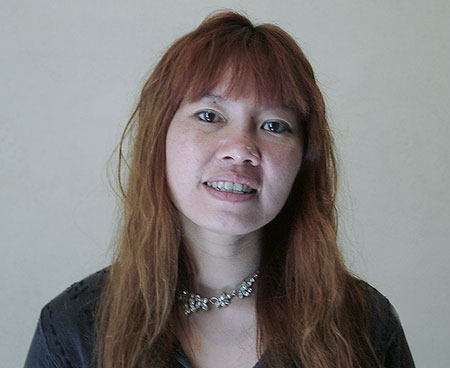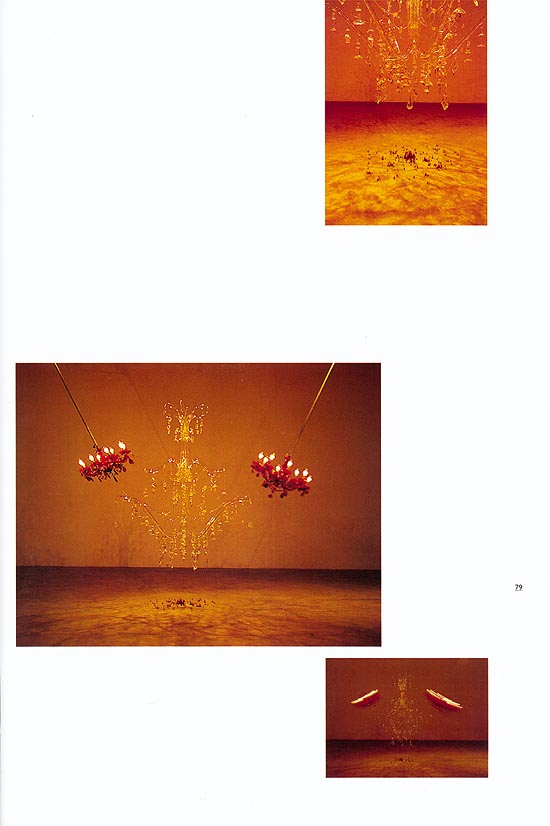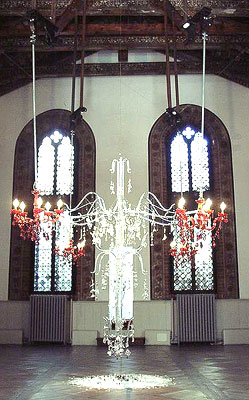
SUZANN VICTOR

Born in Singapore; resides in Sydney. Suzann Victor has emerged as a leading figure in Singapore contemporary art. Her early paintings were abstract and highly expressive. Co-founder of the now defunct alternative space 5th Passage, she has been associated with the development of feminist art discourse in Singapore, although she resists any defined categorisation of her work. Victor’s works frequently capitalise on the power of graphic and theatrical devices, as well as the fluent use of cultural theory in engaging issues. Her works are characterised by a radical curiosity about taboo or sensitive subjects including female genitalia or the post-colonial condition. She has drawn critical attention for her ability to articulate complex ideas in a striking form. Victor’s participation in the 49th Venice Biennale establishes her as serious and committed artist.
Source: Art Forum

Dusted By Rich
Manouevre, 2000
Pendulum mechanisms, antique chandeliers, broken glass, crystals, Pyrex glass
tear drops
Dimensions variable

Even as I invoke
these signifiers to describe myself, I hear the attempts these descriptions make
to still female and feminised bodies. Nonetheless, they are intrinsic components
of my work as they function as offerings which visually embody the Others within
the Other.
![]()
Bodies, burdened with narratives and inscribed by laws , function as signifiers
of the state propaganda and nationalisms that supercede the Individual. The gaps
between these terms, »Asian«, »Woman« and »Artist« conjure up »Region«,
»Gender«, »Politics«. They become sutured to the weights of each other's
Otherness even as they collide into each other.
![]()
Dusted for Rich Manouevre 2001 reappropriates symbols laden with a »European«
sensibility. I have chosen to re-present the crystal chandelier, lifting it as
it were from its historical, cultural and political context so as to incorporate
it as a contemporary response to the post-colonial condition.
![]()
As a signifier of »refined« taste, opulence, wealth and power imported by the
colonial elite to project social and cultural difference from those they
governed, I am seeking to re-make this artifact of colonial power into a symbol
of Chinese proletarian labour. By retaining a particularly »hand-made« quality
through the use of chipped and pre-loved everyday glass vessels which have been
»broken in« in one way or another, one is confronted with the after-image of a
poor Asian woman artist reverently copying her masters in a process of ironical
misrecognition of quality and taste. In so doing, it inherently critiques an
ideology that simultaneously subjugated a host of Asian, Aboriginal and Pacific
Islander bodies in order to ordain the standard of 'civilization' as white,
European, male and rich.
![]()
I see this work as representing the »native's« experience of an object made from
political memory, glimpsed briefly from afar only to be conjured from objects
close at hand. In so doing, it renders more transparently the circuitry between
rituals of the everyday and the rituals of colonisation. As a visual testament
to the ongoing impact of colonialism within the psyche of the colonised, the
work performs the fetishisation of objects that refer to the »glory« of a
colonial past, operating as much as a fetish for the colonised as it is for the
colonisers. Like an act of irony reinvesting in its own loss.
STAR CHARTS & SHATTERED GLASS AT THE
JOHN CURTIN GALLERY
Source: Curtin university of Technology
Objects as diverse as small dishes painted with a map of the skies above Perth to an installation which uses motors used to rock baby's cradles, electric light globes and piles of shattered window glass are incorporated in the current exhibitions at the John Curtin Gallery.
The two July exhibitions relate in part to Australia's proximity to, and cultural engagement with Asia, according to the John Curtin Gallery Director, John Barrett-Lennard.
re-emplace (until Tuesday 20 July) consists of two installations by Sally Smart and Suzann Victor. The works combine the everyday or commonplace and the extraordinary with results that are uncanny and eerie, yet enticing and even humorous.
Prominent contemporary artists from, respectively, Australia and Singapore, Smart and Victor are exploring issues of the body and memory from a feminist perspective, using simple materials like felt, fabric, dolls and mirrors.
"In darkened space of the Gallery, surrounded by felt, reflections, crushed glass, and shadows there is a sense of both familiarity and deep discord," John Barrett-Lennard said.
"Artist Suzann Victor says the works are like 'a passport for encountering or crossing the boundaries that define or shift social, sexual or cultural identity.'
"For the artists, re-emplace is not constructed upon dualities of Australia and Asia, or East and West, but rather on the possibility of dissolving boundaries and finding freedom in doing so.
"Suzann Victor has been included in exhibitions at the Singapore Art Museum, the Queensland Art Gallery, the Havana Biennale in Cuba, in addition to Pakistan, Tokyo, Berlin, Beijing, and Australia. She is currently living and studying in Sydney," Barrett-Lennard said.
"Sally Smart has shown widely in Australia, including in the Moet et Chandon touring exhibition in 1992, 1994 and 1995, and in New York, Korea and Singapore. Parts of her work for re-emplace have recently been shown at the Fukuoka Art Museum, the premier museum for Asian art in Japan.
"re-emplace was first presented at the Dr. Earl Lu Gallery at LaSalle-SIA College of the Arts in Singapore, and the assistance of the Earl Lu Gallery is gratefully ." he said.
Text & Subtext
22 Asian artists come together as part of the international travelling
exhibition Text & Subtext. They all represent contemporary art, coming from
widely different countries such as Singapore, Thailand, India, Korea, Japan,
Vietnam, Taiwan, Indonesia, the Philippines and China.
Today, several of these women live and work outside Asia, and quite a few of
them have already made a name for themselves at various biennials and in
international art circles. This applies, for instance, to Indian artist Nalini
Malini, who has exhibited at Tate Modern in London in 2001, and to Sora Kim,
Korea, and Suzann Victor, Singapore, who were featured at the Venice Biennials
in 1999 and 2001, respectively. But this is the first time that a selection of
vibrant contemporary art from 10 Asian countries can be seen at one exhibition
in Copenhagen.
Text & Subtext itself has been around the world. The initiator of the exhibition
was curator Binghui Huangfu, who was born in Beijing in 1959 and who is the
daily leader of the Singapore gallery Earl Lu and LASALLE-SIA College.
Since the 1970's, women have made their mark on European art. However, in Asia,
the trend is still for women's art to somehow have a lower ranking than men's:
whereas the latter defines the overall text, female art still constitutes a
subtext. Therefore the exhibition title Text & Subtext.
The main common denominator of these artists is their wish to communicate. Using
several different modes of expression, ranging from painting to sculpture, over
photography and video to giant installations, they take on current issues. The
exhibition is about a wide range of subjects such as consumer culture,
nationality, race, taste, sex and sexuality, all of which challenge the modern
individual in a globalised world.
The idea with Text & Subtext has in no way been to say anything in general about
Asian art as a whole. Quite the contrary, in fact: the exhibition salutes
diversity and demonstrates emphatically that Asian contemporary art -
irrespective of nationality or gender - belongs to the forefront of today's
international avant-garde. Here is a unique opportunity to see why that is.
A richly illustrated exhibition catalogue is available, offering background
articles and presentations of all of the artists (in English).
The participating artists from Singapore are: Suzann Victor, Ye Shufang
and Joyce Vyvyann Lim (Singapore).
![]()